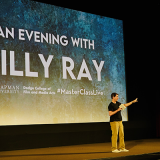Oscar makes room as toon field blooms
November 14, 2011
The animated feature category is now a decade old, and in that time, the category has served up three nominees in all but two of its previous 10 years, when the number of eligible submissions was great enough to expand the ballot to five slots.
Last year nearly made the cut, until CG/live-action hybrid "Yogi Bear" was disqualified, leaving Golden Globe nominees "Despicable Me" and "Tangled" unrecognized by Oscar.
"What a shame that because we were short one film, we lost two nominees," says Acad governor Bill Kroyer, who serves on the short films and feature animation branch.
That's why the org decided to instate an intermediary threshold. If 12 or fewer toons qualify, the race stays small (at three noms), but if 13 or more toons receive theatrical release, the category expands to four noms. And if 16 or more open, there can be five.
It all sounds rather confusing, until one realizes that the net effect is a wider ballot designed to showcase what has become a bigger field.
"As the number of animated features has grown, we wanted the category to reflect that," Kroyer says.
For evidence of that expansion, look no further than the fact that 2011 brought new work from nearly all the top toon outfits: Blue Sky ("Rio"), Pixar ("Cars 2"), DreamWorks Animation (both "Puss in Boots" and "Kung Fu Panda 2"), Walt Disney Animation ("Winnie the Pooh"), Sony Pictures Animation ("The Smurfs"), Aardman ("Arthur Christmas," made in conjunction with Sony), Animal Logic ("Happy Feet Two"), Rhythm & Hues ("Alvin and the Chipmunks: Chipwrecked") and newcomer ILM (for whom "Rango" was its first inhouse animated feature).
Count foreign and indie pics, and there were 18 films in all, suggesting a strong potential for five slots.
This is the point where prognosticators start to examine which films might be disqualified the way "Yogi Bear" was last year. At risk, "The Smurfs" and "Alvin" rely heavily on live-action footage, foreign submissions "Alois nebel" and "Chico & Rita" use a fair amount of rotoscoping (a technique akin to tracing live-action footage), and "Mars Needs Moms," "The Adventures of Tintin" and "Happy Feet Two" blend motion-capture with the keyframe style the Academy prefers.
"We're trying to preserve the animation process as a performance art, not a visual effects art," says Kroyer, whose own CV involves both "traditional" animation and performance-capture experience.
That said, the Academy is generous in its definition: "Every artist from Picasso to Vermeer has used live models, but you look at a Picasso and think, 'That's real art,' and you look at a Vermeer and say, 'Man, he could have taken a photograph and achieved the same effect,'?" notes Kroyer.
In other words, the Academy aims to recognize performances created by animators, not flesh-and-blood actors. To make that determination, the Acad relies on "the word of the filmmaker," Kroyer says. Hence, in 2009, James Cameron insisted his cast was responsible for the perfs in "Avatar," so the Acad overlooked it. This year, since Spielberg believes animators were integral to "Tintin," that film should be a formidable contender in the toon race.
Read the full article at Variety.com

